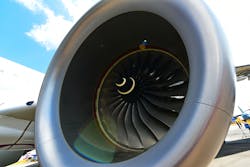Rolls Reports New Turbine Blade Problem
Rolls-Royce Plc revealed a problem with cracked turbine blades on certain Trent XWB engines installed on Airbus A350-900 aircraft, but emphasized that none of the "small number of engines" in which the problem has been discovered had experienced any " abnormal in-flight operation". The jet engine builder added that it is conducting precautionary inspections of all other Trent XWB-84 engines of a similar service life.
The Trent XWB is a high-bypass turbofan engine introduced in 2010 and in service since 2014 as the exclusive engine option for the wide-body Airbus A350 XWB.
According to Rolls-Royce, the initial engines of the series are now approaching their first scheduled shop visits, with "an average of 14 million kilometers with no unplanned maintenance and record low levels of in-flight disruption."
Rolls detailed that inspectors have identified indications of wear in the Intermediate Pressure Compressor (IPC) of engines that have been in service for four to five years. More specifically, Rolls noted that among "just over 100 Trent XWB-84s that have been in service for four to five years," a majority have been inspected and a minority of these engines have shown "signs of wear on an average of only one or two IPC blades.
"We have also taken the precaution of sampling a number of younger Trent XWB-84 engines and have found no unexpected wear," Rolls added.
Rolls-Royce chief engineer Frank Haselbach independently noted that the IPC would normally have a service life that is twice as long as the worn parts now indicate.
The problem for the Trent XWB is reminiscent of an issue involving defective turbine blades in Rolls' Trent 1000 engines installed on Boeing 787 Dreamliner jets. Those defects involved cracking on blades installed in the engines' Intermediate Pressure Turbine (IPT) section. Rolls-Royce determined that problem was caused by sulfurization, and worked to develop and install an alternative blade design.
However, Rolls-Royce has characterized the new issue as one associated with routine maintenance efforts.
"Engines now coming in for overhaul have travelled the equivalent of 350 times around the world, with no unplanned maintenance," according to Chris Cholerton, president of Rolls-Royce Civil Aerospace. "It is reassuring to see that our proactive inspection regime has enabled us to identify and swiftly address this issue and minimize any potential impact on our customers.”
